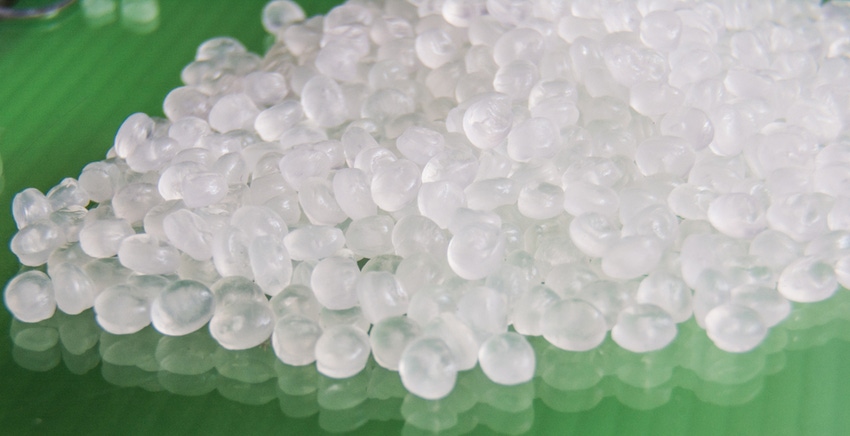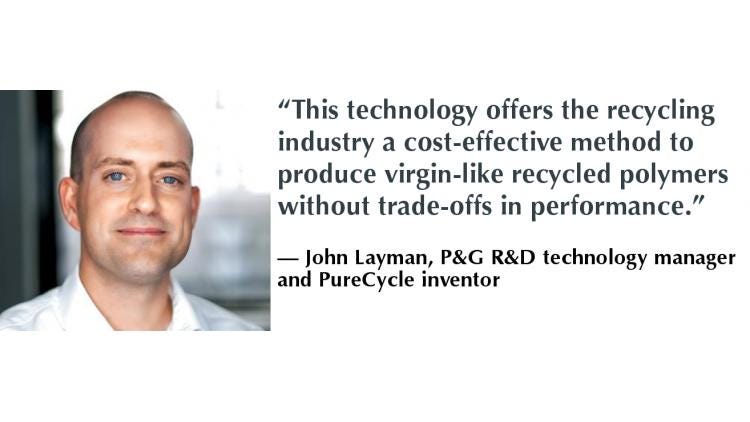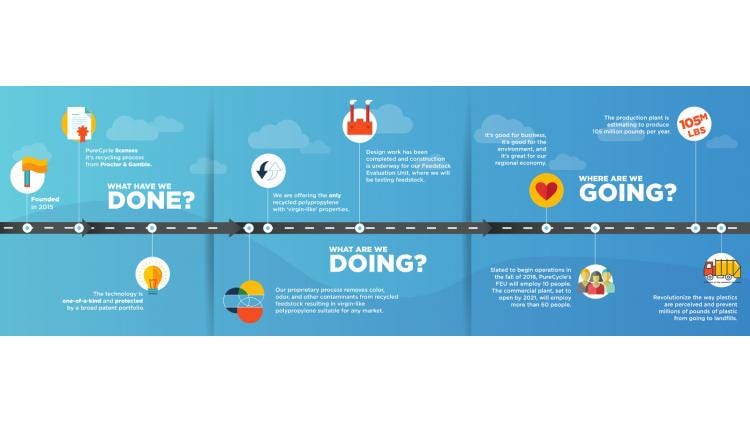
To meet its sustainability goals for recycled content in polypropylene packaging, Procter & Gamble searched for recycled material pure enough to meet its quality standards. When enough of that couldn’t be found, scientists at P&G invented a process to purify recycled PP and licensed the technology to PureCycle Technologies.
P&G announced the technology during a ribbon-cutting ceremony in July 2017 at the plant in Lawrence County, OH, that will produce about 105 million pounds of purified polypropylene a year. With patents granted and others still pending, the PureCycle technology is capable of making recycled PP suitable even for use in food-contact applications. It will help divert plastic otherwise headed for the landfill or into waterways and remove previous limitations on the use of recycled PP because of low quality.
Brent Heist, who leads the global packaging sustainability team at Procter & Gamble, will talk about the proprietary PureCycle process at SPC Impact (Apr. 24-26; San Francisco, CA) on Thurs., Apr. 26 at 10:45 a.m. PST to noon. (There’s still time to register to attend, but hurry!)
In advance of the event, Packaging Digest interviewed John Layman, P&G’s R&D technology manager and founding inventor behind the PureCycle technology, to get more details about the development and its impact for Procter & Gamble and for the packaging industry at large.
Of all the plastics out there being used in packaging, why focus on recycling polypropylene?
Layman: Polypropylene (PP) is one of the most versatile polymers ever created, with global annual production of around 60 million metric tons (second only to polyethylene). Recycled PP is almost always grey or black in color and is difficult to incorporate into plastic articles. This technology purifies recycled polypropylene back to a virgin-like polymer. It will remove colorants, odor and other contaminants from the recycled plastic, enabling the recycled plastic to be in nearly virgin-quality—which was not possible before.
How do you think this development will impact the plastic packaging recycling industry in general?
Layman: This technology offers the recycling industry a cost-effective method to produce virgin-like recycled polymers without trade-offs in performance.

According to the Assn. of Plastics Recyclers (APR), demand for recycled PP in North America alone is estimated at 1 billion pounds, 720 million pounds of which is identified as “high-quality” recycled PP. Why such a high demand for rPP in general?
Layman: Consumers want to feel good about the products they put in their carts. This technology enables companies to provide more sustainable choices.
Why does it have to be “high quality”?
Layman: Brand owners want to offer superior products and packaging is an important part of the consumer experience.
Couldn’t the impurities be hidden inside layers of packaging?
Layman: Our technology removes virtually all containments and makes virgin-like PP, which enables the material to be used in any application where virgin PP is used today.
What percentage of rPP is P&G currently using in its packaging?
Layman: While we cannot share a specific breakdown, we use approximately 34,400 metric tons of PCR [post-consumer recycled] in our plastic packaging. [Click here to see P&G’s sustainability report.]
What will that percentage be after PureCycle begins producing rPP?
Layman: P&G has a long-term environmental vision to use 100% renewable or recycled materials for all products and packaging. The rPP from PureCycle will help P&G make progress against this vision.
Can PureCycle be used to clean other recycled plastics? If so, will it be used for other plastics?
Layman: We are starting with PP and looking at a range of other opportunities.

How would you describe the PureCycle process?
Layman: A solvent-based physical separation/purification process.
Why is it important to note that this is a non-chemical process?
Layman: We want to avoid confusion of the PureCycle process with other chemical depolymerization processes. In chemical depolymerization, a chemical reaction occurs when the polymer is depolymerized back into monomer.
What can you tell us about the purification process? How does it work?
Layman: The purification process is a physical process that uses a solvent to first remove impurities that can migrate and then removes non-soluble contaminants from the rPP.
Is the process to remove impurities, odor and colors done in one step or multiple steps?
Layman: Multiple steps. Each of the two stages of the process plays a specific role in removing different types of unwanted contamination from the rPP.
What percentage of impurities will remain in PureCycle rPP?
Layman: Virtually none. PureCycle aims to make an ultrapure recycled PP product that is comparable to virgin.
How does PureCycle remove nearly all impurities and residual dyes from recycled plastics without negatively impacting the materials performance and properties?
Layman: The PureCycle process purifies recycled plastics at the molecular level. Since there is no chemical reaction taking place, the polymer molecules remain intact as the impurities are removed.
Does it work with different formats of recycled material (such as flakes and pellets)?
Layman: Yes, the process is agnostic to the sample form.
Has the plant’s feedstock evaluation unit come online as expected in January 2018?
Layman: The feedstock evaluation unit (FEU) will come online in the last quarter of 2018.
What does the feedstock evaluation unit do?
Layman: The FEU will be an ongoing asset that will enable PureCycle to screen feedstocks as scrap markets change and evolve over time. Ensuring feedstock flexibility is a critical element to success for any plastics recycling enterprise.
Why is this a necessary step before the plant is operational in 2020?
Layman: In addition to screening feedstocks, the FEU will enable PureCycle to develop a product portfolio and provide samples to offtake partners.
How much of the recycled PP produced is expected to be reused in packaging?
Layman: The recycled PP can be used in any application that virgin PP is used in today, including packaging.
Reports say that, at maximum operating capacity, the plant will accept up to 120 million pounds of plastic per year and produce 105 million pounds of rPP. Why will there be a 20% loss of material?
Layman: The yield loss depends on the amount of contamination in the feedstock. For example, if a PP feedstock contains 5% calcium carbonate, 3% polyethylene and 2% pigments, then that feedstock will only yield 90% PP.
PureCycle rPP will be available for sale to outside organizations; it won’t just be made for P&G. What kind of interest have you gotten from the industry?
Layman: We have received tremendous interest and encouragement from a broad spectrum of companies in the plastics industry. Many companies desire to sell more environmentally responsible products to their customers and PureCycle is a way for companies to do this without trade-offs in performance.
What main point do you want people to take away from Brent Heist’s presentation on PureCycle at SPC Impact?
Layman: This technology demonstrates P&G’s commitment to sustainability and helps in achieving P&G’s 2020 recycling goals—that is, doubling use of recycled resin in plastic packaging and ensuring 90% of product packaging is either recyclable or programs are in place to create the ability to recycle it.
PureCycle technology supports P&G’s vision of using 100% recycled or renewable materials and having zero consumer waste go to landfills. P&G has a long history of sustainability leadership and bringing innovative firsts to the industry—like recycled packaging, concentrated product and sustainability reporting. This technology is another innovative first and will help us achieve our sustainability goals.
***********************************************************************************
Production efficiencies, ecommerce challenges, sustainability trends, new bioplastic technologies and more are among the topics on the agenda at the new Packaging Education Hub at EastPack 2018 (June 12-14; NYC). This free educational program will have more than 15 hours of can’t-miss presentations, demonstrations and hands-on activities. Register to attend for free today!
About the Author(s)
You May Also Like




